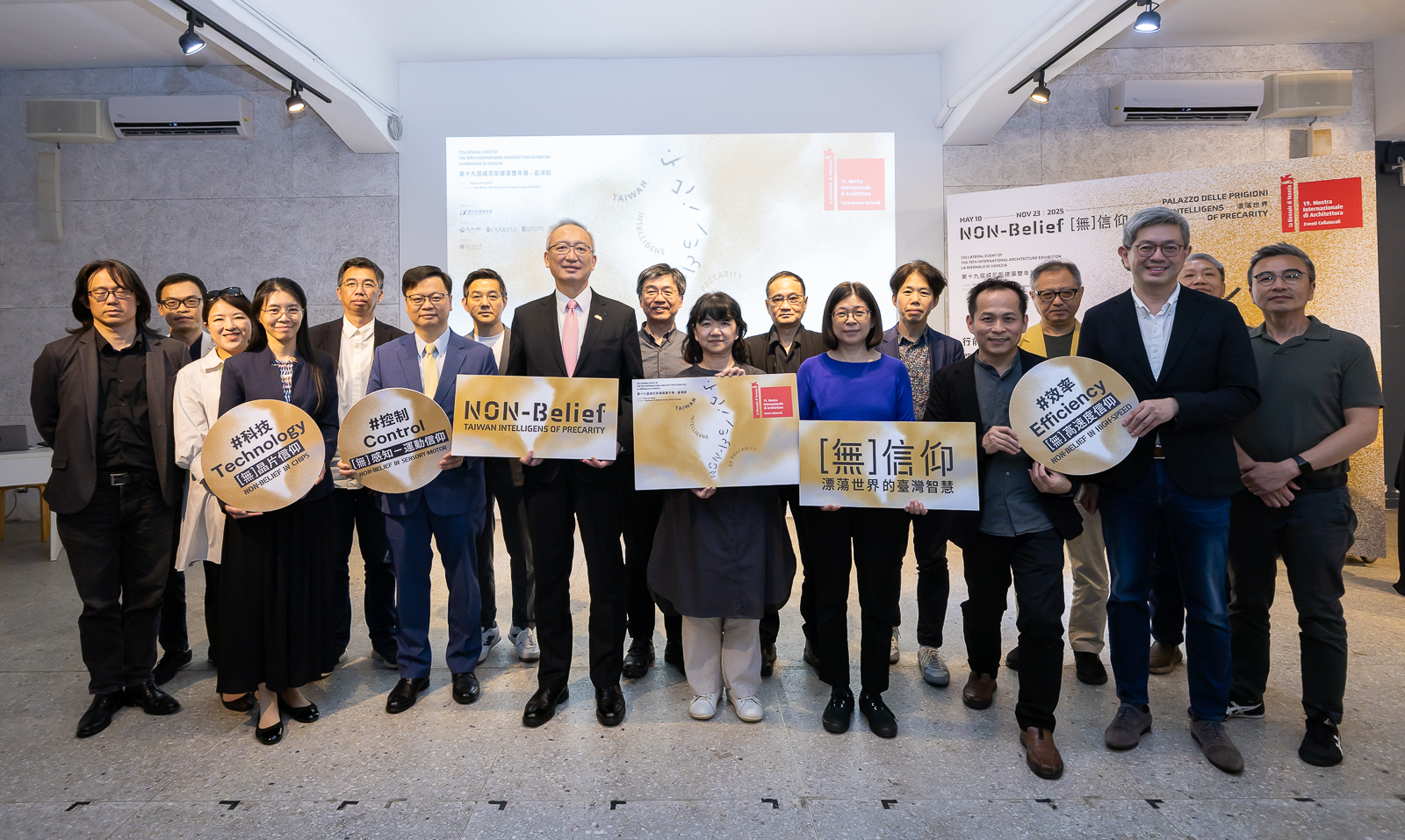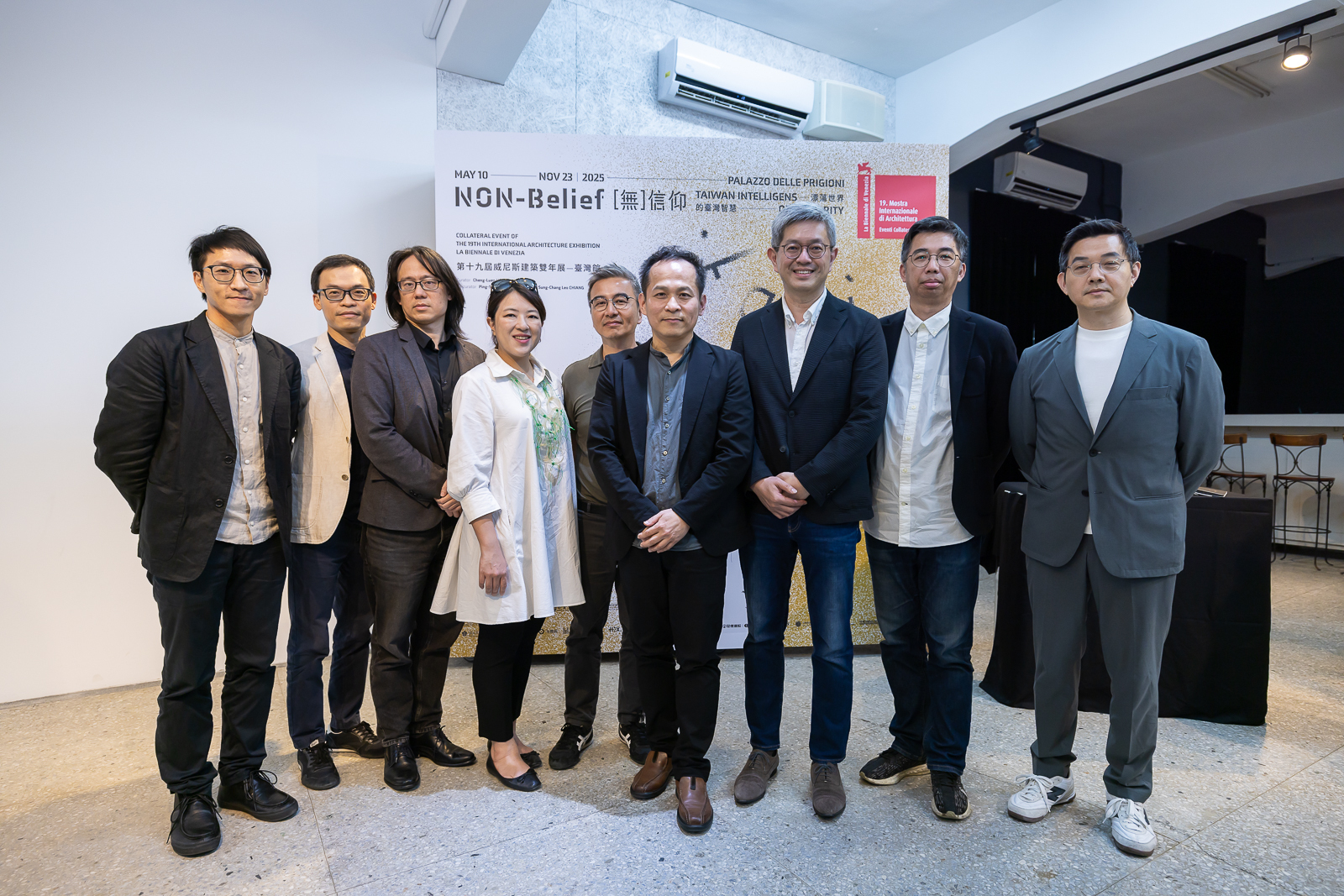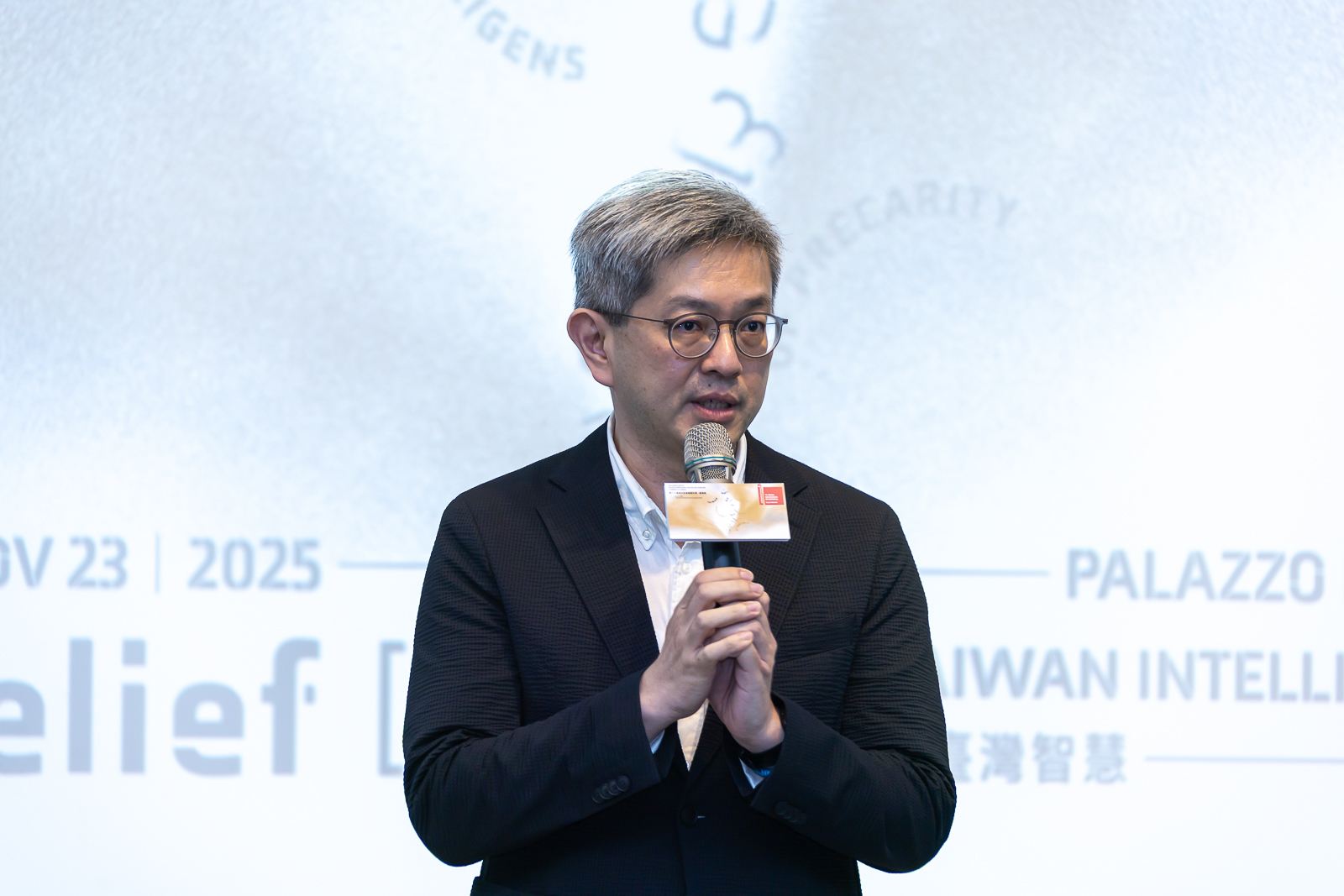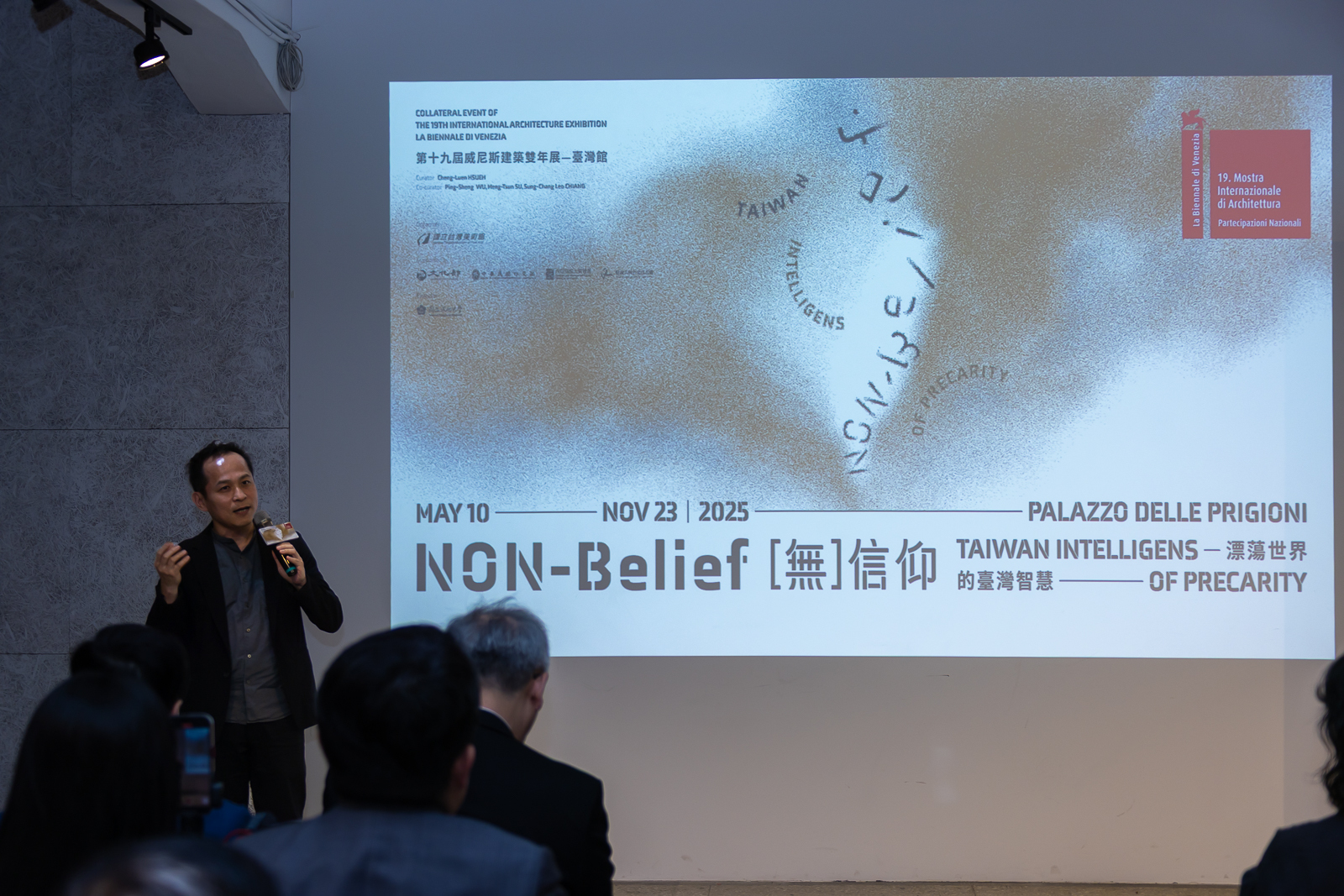NON-Belief: Taiwan Intelligens of Precarity Taiwan Pavilion Set to Embark for the 19th Venice Architecture Biennale
Written by the Department of Architecture in NCKU.Edited by Amy Lin. Image credit to NCKU News Center.

A pre-departure press conference for the Taiwan Pavilion at the 19th Venice Architecture Biennale was held today (April 17). Attendees included Deputy Minister of Culture Jing-Hui Lee, Director of the National Taiwan Museum of Fine Arts Kuang-Yi Chen, Deputy Minister of Foreign Affairs Chih-Chung Wu, jury members Chia-Chi Wang, Guang-Ting Wu, Chun-Hao Hou, Ming-Sung Hsu, Chi-I Chang, and Chih-Kang Chi, NCKU Senior Vice President Ping-Sheng Wu, curator Cheng-Luen Hsueh, and co-curators Meng-Tsun Su and Sung-Chang Leo Chiang, among others.
Organized by the National Taiwan Museum of Fine Arts (NTMoFA) and curated by a team from National Cheng Kung University (NCKU), the Taiwan Pavilion at the 19th Venice Architecture Biennale will present its official exhibition titled NON-Belief: Taiwan Intelligens of Precarity. The exhibition will be on view at the Palazzo delle Prigioni in Venice, Italy, from May 10 to November 23, 2025. A pre-departure press conference was held today (April 17), with attendance by representatives from the Ministry of Culture, NTMoFA Director Kuang-Yi Chen, jury members Chia-Chi Wang, Guang-Ting Wu, Chun-Hao Hou, Ming-Sung Hsu, Chi-I Chang, Chih-Kang Chi, NCKU Senior Vice President Ping-Sheng Wu, curator Cheng-Luen Hsueh, co-curators Meng-Tsun Su and Sung-Chang Leo Chiang, among others.
Rooted in the Biennale’s central theme “Intelligens. Natural. Artificial. Collective.”, NON-Belief: Taiwan Intelligens of Precarity reconsiders Taiwan’s “intelligens adrift” through the lens of historical complexity, ecological vulnerability, and geopolitical uncertainty. The exhibition interrogates how architectural resilience can emerge in the grey zones—where the natural and artificial, belief and non-belief, converge. Curator Cheng-Luen Hsueh observes that in Taiwan, anything can become an object of belief—and belief itself can shift or dissolve with remarkable speed. This sensibility arises from Taiwan’s volatile geography, situated between tectonic plates, typhoon paths, and historically, between empires and political regimes.

Organized by the National Taiwan Museum of Fine Arts under the Ministry of Culture and curated by a team from National Cheng Kung University, the Taiwan Pavilion exhibition at the 19th Venice Architecture Biennale—NON-Belief: Taiwan Intelligens of Precarity—is set to embark for Venice.
In his remarks, National Cheng Kung University (NCKU) Senior Vice President Ping-Sheng Wu, speaking on behalf of President Meng-Ru Shen, expressed gratitude to the Ministry of Culture, the Ministry of Foreign Affairs, the National Taiwan Museum of Fine Arts, and all curatorial partners for their strong support of the NCKU team. Vice President Wu noted that since its founding in Tainan 94 years ago, NCKU has maintained a clear mission and positioning—to contribute to the nation's overall development. Beyond its national contributions, the university has also explored ways to engage more deeply with the international community. He emphasized that culture, architecture, and heritage serve as meaningful platforms for dialogue in this context.
Vice President Wu pointed out that as early as 2005, NCKU had collaborated with Guatemala on a World Heritage project. Serving as the on-site coordinator and co-lead for the project, he observed that although Taiwan faced disadvantages in its international position, culture became a vital medium for open communication. Taiwan gained moral legitimacy through involvement in World Heritage work, enabling interaction with many institutions from countries without diplomatic ties. Years later, representing Taiwan through a curatorial team established by NCKU at the Venice exhibition signals a significant new beginning. Given the substantial shift in Taiwan's international standing, Vice President Wu believes this exhibition offers a fresh perspective on Taiwan through architectural and cultural dimensions.
Vice President Wu further emphasized that NCKU’s Department of Architecture received this curatorial opportunity last year, coinciding with the department’s 80th anniversary. Throughout its eight decades in Taiwan's architectural profession, the department has made significant contributions, experienced dormancy periods, and engaged in moments of reflection and reassessment. He expressed confidence that this exhibition presents an opportunity for faculty, students, and alumni to develop new architectural perspectives. He also expressed optimism about the department’s continued growth and future accomplishments.

In his remarks, NCKU Senior Vice President Ping-Sheng Wu, speaking on behalf of President Meng-Ru Shen, expressed his gratitude to the Ministry of Culture, the Ministry of Foreign Affairs, the National Taiwan Museum of Fine Arts, and all curatorial partners for their generous support of the NCKU team.
By framing precarity as a generative rather than negative condition, the exhibition offers a critique of globalization and presents Taiwan as a technologically advanced island continuously navigating instability through architectural intelligence. It seeks to articulate a Taiwan-specific architectural paradigm of resilience and ingenuity in response to global concerns around technology and sustainability.
The exhibition brings together teams of NCKU faculty, students, and architectural practitioners who have engaged in collaborative research rooted in actual projects. Spanning multiple scales, 17 teams propose new architectural prototypes and paradigms—13 of which feature operative models that invite interaction and open up imaginative spatial thinking. The works explore the grey zones between faith and non-belief under the governance of high-tech and high-speed spatial regimes, and are categorized into four conceptual threads: Tactical Interdependence, Infrastructural Flux, Embodied Resilience, and Adaptive Assemblage—providing a layered framework for engaging with the exhibition.
Some of the key projects include:
-
Elastic Borders: Centered on the underground rail project in Tainan, this installation uses translucent acrylic rods—resembling incense sticks—to symbolize belief in zoning/ floor area. Visitors are invited to ritually imagine volumetric transfers, making the site’s layered history and urban context into a participatory, flexible border that links academia, culture, and community.
-
Climate Justice: This project exposes environmental inequalities in the pursuit of high-tech urbanization with satellite images revealing Taiwan’s urban heat islands burning across the landscape. Everyday narratives urge viewers to see through the lens of environmental justice, reflecting on collective challenges of energy and ecology. A shrine-like installation—a tech altar featuring E Ink labels and microchip-controlled images—depicts burning cityscapes to provoke reflection on NON-Belief between “tech islands” and “eco islands.”.
-
Tāi-uân and Venice: The Embodied Intelligens of Two Island Republics: Through a performative banquet table installation featuring a rotating model of Tainan's historical “Sweet Potato Hill” neighborhood, the project explores the embodiment of intelligence in everyday architecture within the block—analogous to both the archipelagic and unitary architecture of Venice—and represents a NON-Belief in current hegemonic geopolitical norms.
A special highlight is the participation of Biennale curator Carlo Ratti, who collaborated with Bio-architecture Formosana in Taiwan for the project: Path of knowledge – Southern Branch of the National Central Library, reimagining the library ramp as a series of spatial encounters that foster serendipity and shift knowledge from taxonomic systems into serendipitous discovery, embodied, social experiences. It aligns with his curatorial theme, the Latin title Intelligens—which contains the word gens (“people,” “community”)—and redefines intelligens as a human-centric sensibility embedded in space.

Curator Cheng-Luen Hsueh, Chair of NCKU’s Department of Architecture, presented the design concept on site.
The exhibition design is unified by an “island” concept. At its center stands the Technology Island, an installation that integrates E Ink labels cycling through images of Taiwan’s shifting landscapes to reflect the impact of technological development. Surrounding this core are architectural models accompanied by research booklets or QR-coded audiovisual materials for deeper exploration. Another key feature, the Illuminated Votive Wall, showcases traditional Taiwanese deities on one side and a network of glowing microchips and wiring on the other—serving as a symbol of the transition from folk belief to technological futures.
The pavilion will also feature a screening of Island in Between, the Oscar-nominated short documentary by co-curator Sung-Chang Leo Chiang. The film uses the everyday landscape of Kinmen to reflect on Taiwan’s complex identity and geopolitical uncertainty.
During the preview period, the Taiwan Pavilion will host six international forums on the following themes:
-
Architectural Pedagogy – A dialogue on architectural education with professors from both NCKU and Università Iuav di Venezia.
-
Town and Gown – An exploration of innovative collaborations between academia and industry.
-
Curating Precarity: Museum of the Future – A session featuring reflections and insights on architectural curatorial practices and future trends.
-
Inside Outside: Navigating Precarity and Global Flux – A discussion with international architects and Taiwanese practitioners abroad on navigating global precarity.
-
Taiwan Intelligens of Precarity – An in-depth guided discussion focused on the Taiwan Pavilion.
-
Inhabiting Taiwan’s Geopolitics through Moving Images – A conversation led by documentary director Sung-Chang Leo Chiang.
In July, NCKU’s Department of Architecture will also host a Resilient Architecture International Summer Workshop in Venice, fostering academic exchange on architectural education, innovation, and Taiwan’s evolving global architectural identity.
NON-Belief: Taiwan Intelligens of Precarity is curated by Cheng-Luen Hsueh, with co-curators Ping-Sheng Wu, Meng-Tsun Su, and Sung-Chang Leo Chiang. The team includes expert advisor Wei Tseng (Chair, Department of Architecture, Tunghai University) and international advisor Brian McGrath (Professor at Parsons School of Design, New York). The exhibition's cutting-edge installations are made possible through partnerships with industry leaders including E Ink Holdings Inc., which collaborated with the team on electronic paper R&D and applications, and Hongsen Intelligent Technology Co., Ltd., which provided technological and financial support—underscoring Taiwan’s innovative strength in design and technology.
For more information, please visit:
National Taiwan Museum of Fine Arts
Facebook
Instagram
National Taiwan Museum of Fine Arts
Provider:
NCKU News Center
Date:
2025-04-21




